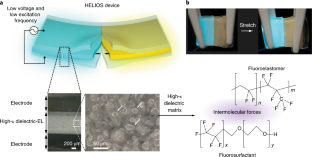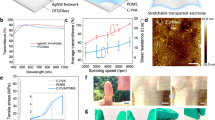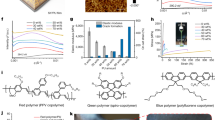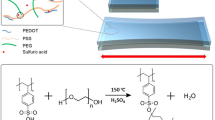Abstract
Stretchable optoelectronic materials are essential for applications in wearable electronics, human–machine interfaces and soft robots. However, intrinsically stretchable optoelectronic devices such as light-emitting capacitors usually require high driving alternating voltages and excitation frequencies to achieve sufficient luminance in ambient lighting conditions. Here, we present a healable, low-field illuminating optoelectronic stretchable (HELIOS) device by introducing a transparent, high permittivity polymeric dielectric material. The HELIOS device turns on at an alternating voltage of 23 V and a frequency below 1 kHz, safe operating conditions for human–machine interactions. We achieved a brightness of 1,460 cd m−2 at 2.5 V µm−1 with stable illumination demonstrated up to a maximum of 800% strain. The materials also self-healed mechanically and electronically from punctures or when severed. We further demonstrate various HELIOS light-emitting capacitor devices in environment sensing using optical feedback. Moreover, our devices can be powered wirelessly, potentially enabling applications for untethered damage-resilient soft robots.
This is a preview of subscription content, access via your institution
Access options
Access Nature and 54 other Nature Portfolio journals
Get Nature+, our best-value online-access subscription
$29.99 / 30 days
cancel any time
Subscribe to this journal
Receive 12 print issues and online access
$259.00 per year
only $21.58 per issue
Buy this article
- Purchase on Springer Link
- Instant access to full article PDF
Prices may be subject to local taxes which are calculated during checkout






Similar content being viewed by others
Data availability
The data that support the findings of this study are available from the authors on reasonable request.
References
Tee, B. C. K. et al. A skin-inspired organic digital mechanoreceptor. Science 350, 313–316 (2015).
Yokota, T. et al. Ultraflexible organic photonic skin. Sci. Adv. 2, e1501856–e1501856 (2016).
Hammock, M. L., Chortos, A., Tee, B. C. K., Tok, J. B. H. & Bao, Z. 25th anniversary article: the evolution of electronic skin (e-skin): a brief history, design considerations, and recent progress. Adv. Mater. 25, 5997–6038 (2013).
Sekitani, T. & Someya, T. Stretchable, large-area organic electronics. Adv. Mater. 22, 2228–2246 (2010).
Chou, H.-H. et al. A chameleon-inspired stretchable electronic skin with interactive colour changing controlled by tactile sensing. Nat. Commun. 6, 8011 (2015).
Larson, C. et al. Highly stretchable electroluminescent skin for optical signaling and tactile sensing. Science 351, 1071–1074 (2016).
Lu, N. & Kim, D.-H. Flexible and stretchable electronics paving the way for soft robotics. Soft Robot. 1, 53–62 (2014).
Kim, R.-H. et al. Waterproof AlInGaP optoelectronics on stretchable substrates with applications in biomedicine and robotics. Nat. Mater. 9, 929–937 (2010).
Shepherd, R. F. et al. Multigait soft robot. Proc. Natl Acad. Sci. USA 108, 20400–20403 (2011).
Sekitani, T. et al. Stretchable active-matrix organic light-emitting diode display using printable elastic conductors. Nat. Mater. 8, 494–499 (2009).
Wang, J., Yan, C., Chee, K. J. & Lee, P. S. Highly stretchable and self-deformable alternating current electroluminescent devices. Adv. Mater. 27, 2876–2882 (2015).
Kim, E. H. et al. Organic light emitting board for dynamic interactive display. Nat. Commun. 8, 14964 (2017).
Cao, Y. et al. Self-healing electronic skins for aquatic environments. Nat. Electron 2, 75–82 (2019).
Sekitani, T. et al. A rubberlike stretchable active matrix using elastic conductors. Science 321, 1468–1472 (2008).
Etienne, P. et al. Self-healing stretchable wires for reconfigurable circuit wiring and 3D microfluidics. Adv. Mater. 25, 1589–1592 (2013).
Yin, D. et al. Efficient and mechanically robust stretchable organic light-emitting devices by a laser-programmable buckling process. Nat. Commun. 7, 11573 (2016).
Wang, J. et al. Extremely stretchable electroluminescent devices with ionic conductors. Adv. Mater. 28, 4490–4496 (2016).
Yen, W. M., Shionoya, S. & Yamamoto, H. (eds) Phosphor Handbook 2nd edn (CRC Press/Taylor and Francis Group, 2006).
Tan, Y. J., Wu, J., Li, H. & Tee, B. C. K. Self-healing electronic materials for a smart and sustainable future. ACS Appl. Mater. Interfaces 10, 15331–15345 (2018).
Wallin, T. J., Pikul, J. & Shepherd, R. F. 3D printing of soft robotic systems. Nat. Rev. Mater. 3, 84–100 (2018).
Ribeiro, C. et al. Electroactive poly(vinylidene fluoride)-based structures for advanced applications. Nat. Protoc. 13, 681–704 (2018).
Cao, Y. et al. A transparent, self-healing, highly stretchable ionic conductor. Adv. Mater. 29, 1605099 (2017).
Yang, C. H., Chen, B., Zhou, J., Chen, Y. M. & Suo, Z. Electroluminescence of giant stretchability. Adv. Mater. 28, 4480–4484 (2016).
Zhou, Y. et al. Bright stretchable electroluminescent devices based on silver nanowire electrodes and high-k thermoplastic elastomers. ACS Appl. Mater. Interfaces 10, 44760–44767 (2018).
Tsangaris, G. M., Psarras, G. C. & Kouloumbi, N. Electric modulus and interfacial polarization in composite polymeric systems. J. Mater. Sci. 33, 2027–2037 (1998).
Davis, J., Hsieh, Y.-H. & Lee, H.-C. Humans perceive flicker artifacts at 500 Hz. Sci. Rep. 5, 7861 (2015).
Bredol, M. & Schulze Dieckhoff, H. Materials for powder-based AC-electroluminescence. Materials 3, 1353–1374 (2010).
Stauffer, F. & Tybrandt, K. Bright stretchable alternating current electroluminescent displays based on high permittivity composites. Adv. Mater. 28, 7200–7203 (2016).
Cordier, P., Tournilhac, F., Soulié-Ziakovic, C. & Leibler, L. Self-healing and thermoreversible rubber from supramolecular assembly. Nature 451, 977–980 (2008).
Li, S., Peele, B. N., Larson, C. M., Zhao, H. & Shepherd, R. F. A stretchable multicolor display and touch interface using photopatterning and transfer printing. Adv. Mater. 28, 9770–9775 (2016).
Shepherd, R. F., Stokes, A. A., Nunes, R. M. D. & Whitesides, G. M. Soft machines that are resistant to puncture and that self seal. Adv. Mater. 25, 6709–6713 (2013).
Rich, S. I., Wood, R. J. & Majidi, C. Untethered soft robotics. Nat. Electron 1, 102–112 (2018).
Markvicka, E. J., Bartlett, M. D., Huang, X. & Majidi, C. An autonomously electrically self-healing liquid metal–elastomer composite for robust soft-matter robotics and electronics. Nat. Mater. https://doi.org/10.1038/s41563-018-0084-7 (2018).
Kresse, G. & Furthmüller, J. Efficient iterative schemes for ab initio total-energy calculations using a plane-wave basis set. Phys. Rev. B 54, 11169–11186 (1996).
Daly, S., Kunkel, T., Sun, X., Farrell, S. & Crum, P. Viewer preferences for shadow, diffuse, specular, and emissive luminance limits of high dynamic range displays. SID Int. Symp. Dig. Tech. 44, 563–566 (2013).
Li, C.-H. et al. A highly stretchable autonomous self-healing elastomer. Nat. Chem. 8, 618–624 (2016).
Acknowledgements
B.C.K.T. acknowledges support from the Singapore National Research Fellowship (NRFF2017-08), an NUS Start-up Grant and the Singapore National Robotics Programme (NRP 1822500053). J.Ho acknowledges support from National Research Foundation Singapore (NRFF2017-07) and an NUS Young Investigator Award. We thank Z. Goh for assistance with the illustration in Fig. 1a and W. Lee for photographs in Fig 1b. We thank A. Cheong, X. Tan and H. Li for access to testing equipment.
Author information
Authors and Affiliations
Contributions
Y.J.T. and B.C.K.T conceived the idea. B.C.K.T. directed the research activities. Y.J.T. and B.C.K.T. designed and led the experiments (with input from H.G., G.C., S.T.M.T., G.X.W., G.L., P.M.L., Y.C., S.L., R.F.S. and J.H.). Y.J.T., H.G., G.C., G.X.W. and B.C.K.T. contributed to data analysis and interpretation. Y.J.T. and B.C.K.T. wrote the paper, and all authors provided feedback.
Corresponding author
Ethics declarations
Competing interests
The authors declare no competing interests.
Additional information
Publisher’s note Springer Nature remains neutral with regard to jurisdictional claims in published maps and institutional affiliations.
Extended data
Extended Data Fig. 1 Thickness effect of dielectric-EL on the brightness of HELIOS 70EL at the same E and fac.
(a-b) The brightness of HELIOS 70EL increases with the increase in thickness in the dielectric-EL (t = 100 µm vs t = 1500 µm) when comparing with the same E and frequencies applied. The measurements were repeated on three samples and the error bars represent the standard deviation. The luminance and the operated fields on the HELIOS devices are expressed using the equation of L = Lo exp(−b/E0.5). Insets show the photographs of the oblique view of the HELIOS device. (c-d) Photographs showing that the HELIOS-thick 70EL device is significantly brighter than the HELIOS-thin 70EL device.
Extended Data Fig. 2 Mechanical tests.
(a) The stress-strain curve of the HELIOS dielectric stretched at different speeds. The modulus increases when stretching at higher speed, which is the typical behaviour of supramolecular polymers22,36. (b) Photograph showing tensile bar specimen (Type V) following ASTM standard D638 with 7.62 cm (gauge length) x 3.18 cm (width). (c) Dielectric-EL sample and (d) three-layered HELIOS device samples were subjected to ten loading-unloading cycles (loading at 1 mm s−1 and unloading at 1 mm min−1). These materials recovered to its original length when subjected to a strain of 50% over time.
Extended Data Fig. 3 Demonstration of HELIOS-thin (t = 67 µm) vs HELIOS-thick (t = 1 mm) LEC devices stretched to various strains.
(a) HELIOS-thin can stretch to ~1.6 times its original length. Scale bar: 5 mm. (b) Photographs showing that HELIOS-thick activated at fac of 200 V and 50 Hz (vaguely visible), and the device is bright when operated at 800 V (and 1000 V) and fac of 50 Hz when operated under daylight condition. Scale bar: 5 mm. (c) The HELIOS-thick device stretches with an increase in light emission and subsequently exhibited stable illumination up to 9 times its original length.
Supplementary information
Supplementary information
Supplementary Figures 1–21, Tables 1–2, Notes 1–5 and refs. 1–18.
Supplementary Video 1
Demonstration of low activation voltage and high brightness: brightness in daylight. This video demonstrates that the luminance from the HELIOS device can be perceived by human eyes under daylight conditions even at low activation voltages, while the control (Ecoflex-EL) requires a much higher activation voltage. The brightness of the HELIOS device is comparable to the maximum brightness of a smartphone display when activated at a Vac of 200 V. Towards the end of the video, the HELIOS device is illuminated at a Vac of 200 V in daylight conditions and twisted, manually demonstrating its softness and flexibility .
Supplementary Video 2
Demonstration of the stretchability of the dielectric material. This video shows that our dielectric layer is elastic and can recover to its original length upon the removal of forces .
Supplementary Video 3
Interfacial bonding between materials. First, we demonstrate that the HELIOS dielectric-EL does not stick to another HELIOS dielectric-EL. Then, we show that the HELIOS dielectric-EL adheres very well to a HELIOS electrode. We cannot peel the materials from each other. We also show that the HELIOS electrode does not stick to silicone (the control material). In the final part of the video, we show that the HELIOS dielectric-EL does not stick to the conventionally used electrode for EL devices, which is PET coated with ITO. The ITO/PET electrode is very rigid and not as transparent.
Supplementary Video 4
Demonstration of dielectric material properties: non-tacky surface. The dielectric is transparent and not tacky. The surface of the material is not self-sticking.
Supplementary Video 5
Demonstration of dielectric material properties: self-healing part A (tensile test). A dielectric material (~1 mm thick) was cut into a tensile coupon. The specimen was then cut in half, and the cut surfaces pressed back together with ~0.08 N force; the material was left to self-heal for 24 h. The video shows the healed material being pulled till fracture.
Supplementary Video 6
Demonstration of dielectric material properties: self-healing part B. After a thick dielectric material (~2 mm thick) is cut in half and the cut surfaces are pressed back together, the material starts to self-heal in one minute. The material formed at the interface is observed when we pull the two ends of the bifurcated and healed sample. After the cut-and-pressed sample is left long enough, the material heals completely. The healed sample does not fail at the cut interface when stretched until it is stretched to the original point of failure, indicating that the healed interface recovers the original toughness.
Supplementary Video 7
Punctures and repeatable healing of a HELIOS LEC device. We show that when using a non-self-healing dielectric-EL (PDMS is used as the dielectric here), optical healing is not achieved. The operating voltage and frequency for this device were Vac = 3,000 V and fac = 800 Hz. When punctured by a needle (27 gauge), the current through the needle is large and quickly generates heat to deteriorate the dielectric, causing sparks. The sample burns and breaks down. In contrast to the control, the HELIOS device can be illuminated at Vac = 1,700 V and fac = 800 Hz with the same brightness as the control. The HELIOS device can also remarkably self-heal to regain its optical performance. When punctured by a needle, the luminance dims around the pierced region. However, immediately after removing the needle, the optical healing effect is observed. We further puncture the same sample and repeat the same procedure a few times with thicker needles (26 gauge, 20 gauge). The HELIOS device self-heals immediately (with no time lag for healing) from every puncture. Then, we illuminate the HELIOS device at the same electrical conditions as the control, that is, Vac = 3,000 V and fac = 800 Hz. The specimen that is punctured multiple times still works, with brighter illuminance, as expected. After being punctured by a needle (27 gauge), the sample can still illuminate at the same brightness. In the HELIOS device, even though there is a short circuit between the electrodes, the amount of current flowing through the needle and the subsequent heat generated due to the flow of current are small enough not to damage the device. Moreover, the HELIOS device self-heals from damage. These reasons show the robust performance when punctured with a needle.
Supplementary Video 8
Soft gripper with a HELIOS device: light sensing of objects in the dark. In the first part of the video, the bottom part of the soft gripper is shown. There are three HELIOS devices and one photodetector at the bottom of the gripper. When the gripper is searching for objects, it lights up at Vac = 200 V and fac = 50 Hz; when it is ready to grasp an object, it will blink at Vac = 200 V and fac = 5 Hz. Later in the video, we demonstrate that the soft gripper can seek and subsequently grasp an apple.
Supplementary Video 9
Soft gripper with puncture-resistant HELIOS device. A HELIOS device embedded in a soft gripper can also self-heal in optical performance. When punctured by a needle, the luminance dims around the pierced region. Immediately after removing the needle, the optical healing effect is observed, with the sample recovering its initial brightness. Later in the video, we show the soft gripper grasping a balloon. We pierce the gripper through the HELIOS device until we burst the balloon being grasped. The puncture-resistant soft gripper and HELIOS device are both functional after the perforation.
Supplementary Video 10
Wirelessly operated HELIOS soft gripper. Silicone-EL (left) and HELIOS (right) LEC devices were embedded inside the bottom of a gripper. A “wireless disc” is on top of the gripper. A power harvester connected to a control circuit was all fabricated and soldered on flexible PCBs, subsequently encapsulated in the wireless disc. A yellow LED is connected in the circuit to indicate that wireless power is being transmitted to the LEC devices. When an external radiofrequency coil is brought close to the silicone-EL gripper, the yellow LED lights up, indicating that power was transferred to the silicone-EL. However, the voltage provided is not enough to illuminate the LEC. Conversely, the HELIOS device can be illuminated.
Rights and permissions
About this article
Cite this article
Tan, Y.J., Godaba, H., Chen, G. et al. A transparent, self-healing and high-κ dielectric for low-field-emission stretchable optoelectronics. Nat. Mater. 19, 182–188 (2020). https://doi.org/10.1038/s41563-019-0548-4
Received:
Accepted:
Published:
Issue Date:
DOI: https://doi.org/10.1038/s41563-019-0548-4
This article is cited by
-
Robot, repair thyself: laying the foundations for self-healing machines
Nature (2024)
-
Mass-produced and uniformly luminescent photochromic fibers toward future interactive wearable displays
Light: Science & Applications (2024)
-
Body-conformable light-emitting materials and devices
Nature Photonics (2024)
-
Intrinsically stretchable light-emitting drawing displays
npj Flexible Electronics (2024)
-
Wearable and interactive multicolored photochromic fiber display
Light: Science & Applications (2024)



